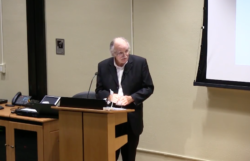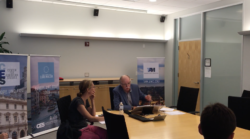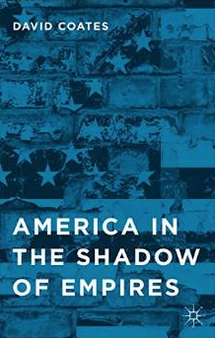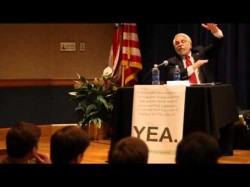The Democrats and the Donald
People of all kinds of political persuasions are rightly horrified by the violence erupting at Trump rallies,1 and by the demagoguery of the candidate himself.2 People of a more progressive predisposition are often equally disturbed by the hold that Donald Trump appears to have on the support of at least sections of the white working class, and by his willingness to consolidate that support by rhetoric that is implicitly racist, misogynistic and anti-Muslim. Commentators often link the two, talking of the anger of a white working class long abandoned by the political elites in both parties that Donald Trump so regularly castigates.
We therefore face three distinctive but linked political phenomena: violence at rallies, reminiscent to some of Germany in the 1930s; white male working-class support for a racist and misogynistic agenda;3 and the presence at the head of the Republican presidential pack of a demagogue whose level of personal self-confidence is only matched by the amount of fear which that self-confidence generates in so many of his critics.4 Watching this from afar, the London-based Financial Times recently wondered “if America has gone barking mad?” If the answer we make to that question is ultimately to be “no, we have not,” we have to be able to explain to ourselves and to others how this trilogy of horror has actually come into existence.
I
The violence at the rallies has two main immediate sources, both of which ultimately come back to Donald Trump himself. His rhetoric, from the beginning of his campaign, has been inflammatory, divisive and racist5 – giving legitimate and huge offense to people who are none of those things. And when the bravest of those have tried to register their unease, by demonstrating – almost always initially peacefully – at Trump rallies, they have been met with brutal treatment by Trump’s minders, with that brutality condoned and at times even encouraged from the podium by Trump himself. We have all seen the video clips now of Trump demeaning hecklers and praising those who “take a swing at them.”6 As even one of his potential supporters put it, when watching the violence unfold: “he could certainly have done things to calm things down, but a lot of his appeal is that he gets people riled up. He stirs people up. It’s hard to stir people up and then at the last possible instant tell them to stop. It’s a momentum heading towards violence.”7 That judgment seems exactly right; and because it is, there can be no doubt about this much at least. Responsibility for the violence is ultimately Donald Trump’s, and his alone.
But that his divisive and inherently racist rhetoric strikes such a deep chord in many of his supporters is not his responsibility alone. Rather, and as Gary Younge among others has correctly emphasized (when claiming that “it’s the Racism, Stupid,”8) here at least the Republican Party is reaping the full harvest of what it has long sown – its “southern strategy” of weaning working-class voters away from the Democratic Party by playing on their fears and by appealing to the worst of their instincts. Drafted in reaction to the hegemony of liberal Democrats in Washington DC in the immediate post-Kennedy years, Nixon’s “southern strategy” was designed to tap into, and reinforce, racist elements in white working-class social attitudes and political sympathies – giving political expression to that which could no longer be publicly named. It was that southern strategy which then consolidated a new and powerful electoral bloc behind Republican Party leadership: an electoral bloc of, on the one side, social conservatives and Protestant evangelicals, and on the other, southern white workers determined not to surrender power, resources or even employment to long-oppressed minorities.
Donald Trump did not create the Republican Party’s southern strategy. Richard Nixon did. Trump simply exploited its full electoral potential by breaking the one cardinal rule that hitherto wrapped that strategy in the political equivalent of Harry Potter’s invisibility cloak. He is actually giving voice to the racist sentiments that the southern strategy both feeds on and fuels – alienating as he does so a party establishment used to playing the game of political correctness while reinforcing (by its policies) the denial of resources to minorities that the racism requires. It is not that Donald Trump is more racist than the Republican Party establishment. It is rather than he is more honest about the racism; and he is winning a certain kind of working class support precisely for that reason. “He tells it as he sees it,” and his supporters applaud him precisely because he does. The Republican establishment may now groan and splutter as the Trump take-over of their party continues apace; but they have only themselves to blame. They created the gap between underlying reality and obfuscating rhetoric on which Donald Trump is now calling them out – and because they did, they richly deserve all the chaos now surrounding them and all the blame that they are currently getting.
II
So what does all this mean for the Democratic Party? What responsibilities fall to it, and what lessons must it learn if it is to meet those responsibilities to the full?
Given the inability of the Republican Party establishment to block the rise of Donald Trump, the responsibility that falls to the Democrats is to put a Democrat in the White House, ideally one that can pull the Senate back into Democratic hands by the electoral power of her/his coat-tails. The lesson to be learned is that before the Democratic Party can be certain that it will win in that fashion, the political priorities and detailed policies to be pursued must also now change: and they must change because the policies and priorities of the Party prior to the financial crisis of 2008 inadvertently helped make the rise of Donald Trump possible.
III
That last claim may sound counter-intuitive: but sadly it is not. For Donald Trump’s appeal to many of his supporters – particularly his appeal to white working class men – is that he offers something new, something different, something other than politics as usual in Washington DC – and he makes that appeal to a voting bloc that is angry about the prolonged inability of “politics as usual” to address their particular economic and social concerns.9 But in order for him to be able to exploit such a gap between a key bloc of voters and the entire political class in Washington DC, that gap itself had already to be in existence. Donald Trump didn’t create the gap. It was there before he launched his presidential bid; and for him now to be able credibly to offer himself as the one person who will bridge it, the leaders of the parties he challenges must already have failed to bridge it before him.
As we have seen, the Republican Party elites failed that bridging exercise by pretending to service working class economic interests and a conservative social agenda, while actually delivering on neither. As Nicholas Kristof recently put it: in part “Republican leaders brought [the Trump phenomena] on themselves. Over the decades they pried open a Pandora’s box, a toxic politics of fear and resentment, sometimes brewed with a tinge of racial animus, and they could never satisfy the unrealistic expectations that they nurtured among supporters.”10 But recent Democratic Party elites failed that bridging test too; and they did so by failing to effectively address, over a long period of time, key working-class concerns about employment, job security, employment rights and wages. They did so by making what Thomas Frank recently labelled “a realignment of choice:”11 a deliberately adopted shift of focus by Democratic Party elites away from working class-concerns in pursuit of the votes of the affluent. It was this failure – beginning in the 1970s and intensifying through the Reagan and post-Reagan years – which created the electoral opportunity that the Republican Party then seized, and on which Donald Trump is now capitalizing.
The task of Democratic Party leadership in this electoral cycle, therefore, is not simply to stop Donald Trump. It is to find ways of rapidly reversing the erosion of the electoral bonds between a progressive party of the center-left and key sections of its potential working-class base: and to do so, not by appealing to the worst instincts of that base, but by demonstrating to would-be voters that progressive policies serve their economic and social interests best.
IV
This weakening of the link between an ostensibly progressive party and its working-class base is not just an American story. You see it equally clearly in the UK with Tony Blair’s New Labour weakening of working-class institutions, where the recent loss of working-class support for the British Labour Party is equally striking, and where the rise of authoritarian populism – in the form there of Nigel Farage and the UK Independence Party – is eerily similar to the rise of Donald Trump here.12 For in the United Kingdom, no less than in the United States, the leading party of the center-left spent the two decades before the 2008 financial crisis retreating from much of its earlier radicalism, making its peace instead with a newly re-energized conservatism. On both sides of the Atlantic, it is with the long-term electoral consequences of that retreat that progressive forces are now faced, and which they must now contain.
For what New Labour did in the UK, and what the Democratic Party under Bill Clinton did in the United States, was to buy into the entire free-market anti-government analysis and agenda then being developed and advocated by their political opponents. It was the Democratic Party under Bill Clinton – and not just the Republican Party led by Newt Gingrich – that promised “to end welfare as we know it.” It was the Democratic Party under Bill Clinton – and not just the Republicans led by George Herbert Bush – that tolerated growing income inequality, the outsourcing of American manufacturing jobs, and the signing of trade agreements (NAFTA being the classic case) that facilitated that outsourcing. And it was the Democratic Party under Bill Clinton – and not just the Republican Party under Ronald Reagan – that failed to strengthen trade rights to organize and to collectively bargain, and that then stood idly by as Republican activists triggered right-to-work legislation in state after state, stripping away the rights of collective labor institutions that once had protected American wages and working conditions from an open-ended “race to the bottom.” The American Right launched a deliberate and well-funded ideological onslaught in the 1980s and 1990s on the remaining legacies of America’s once proud New Deal, and on the working-class institutions that sustained it, an onslaught paralleled in the United Kingdom by the Thatcher revolution against the post-war welfare state. And like Tony Blair’s New Labour, the “new Democrats” led by Bill Clinton chose in the 1990s to capitulate before that onslaught rather than to reject it for the pernicious class project that in reality it was.
Bernie Sanders is now much criticized for wanting to turn the United States into Denmark. The criticism is unjust, of course. That is not his aim. But the fact that much of what he aspires to bring to the presidency are policies already in place in the more advanced welfare capitalisms of the European Union does point to the degree to which the United States has slipped back from the position of leadership in welfare provision that it enjoyed during the days of the New Deal. It also points to the failure of the post-war generations of Democratic politicians to defend and strengthen basic social democratic institutions and working-class rights, or to fight back effectively against carefully orchestrated rightwing ideological assaults on the use of government programs to win the war on poverty. It points, that is, as Thomas Frank has it, to the fact “that it is time to face the obvious: that the direction the Democrats have chosen to follow has been a failure for both the nation and for their own partisan health.”13
V
The Democratic Party was, and remains, a major political vehicle for the advancement of minority rights. That is its great strength. The Democratic Party also used to be, but is no longer, a major political vehicle for the strengthening of working-class institutions and the advancement of working-class rights. That is now its great weakness. Bernie Sanders is trying to turn it back into both, by building a campaign focused on income inequality and the outsourcing of jobs; and he needs to be both congratulated and supported for the effort. But even he is not putting “the people’s budget”14 at the heart of his political campaign. His focus is still on the elites and their corruption of the democratic political process. That corruption is important, but it is not the only issue that needs to be in play. There is the embryo of a fully developed class analysis in the standard Sanders’ stump speech, but thus far that class analysis is there in embryonic form only. As we have argued before, we need it full out and center-stage.15
Bernie Sanders at least has a pedigree here. His commitment to such a transformative politics is not in doubt. Hillary Clinton’s, by contrast, has to be. She struggles to consolidate white working-class support now, particularly among men16 – in ways that Bernie Sanders does not – precisely because her family name is so indelibly linked to a Democratic Party elite structure that allowed the New Deal electoral coalition to disintegrate and the white working class to slip away. Hillary Clinton’s record on women’s and minority rights is at least as strong as Bernie Sanders – better than his in many cases – but she is still, in the minds of so many progressives, firmly associated with a politics of triangulation and elite indulgence. Which is why her current conversion to a more radical critique of the latter seems, to many progressives, to be just that – a very recent conversion – and why they rightly worry about its sincerity, its depth and its staying power. It is also why the test issue here, for many progressives, is the TPP. Hillary Clinton now says she is against it – that she no longer favors this particular free-trade deal – but there are many commentators out there (and not just progressive ones) who wonder if that opposition is actually genuine, and whether it will actually last.
Hillary Clinton currently has a “trust” problem on two fronts, not just on one. Conservatives don’t trust her, not least because they associate her with the foreign policy of both Bill Clinton and Barack Obama, both of whom many conservatives literally loath. And progressives don’t trust her because her attacks on Wall Street excess seem so contrived and so forced. She will never win that first trust battle, but unless she can somehow win the second one – pulling Sanders-supporting progressives enthusiastically to her side – the danger remains that she will not, in November, be able to mobilize a level of grass roots enthusiasm sufficiently to match the conservative equivalent now available to Donald Trump. Which is why, when asking ourselves the key questions – who is best placed to defeat Donald Trump in November,17 and who is best placed to pull the Senate back into Democratic control – many of us still believe that the answer is not Hillary Clinton. It is Bernie Sanders.
1 http://thinkprogress.org/politics/2016/03/17/3760438/trump-hate-map/?utm_source=newsletter&utm_medium=email&utm_campaign=tptop3&utm_term=1&utm_content=53&elqTrackId=2343b9c3f1154f95a25e4f754bd6a510&elq=28df71c93473476cab72a04926890c2f&elqaid=29494&elqat=1&elqCampaignId=5247
3 Alexandra Rosenmann, Half of American Women Hate trump According to New Poll, posted on Alternet.org, March 17, 2016: available at http://www.alternet.org/comments/election-2016/half-american-women-hate-trump-according-new-poll
4 David Brookes, “No. Not Trump, Not Ever,” The New York Times, March 18, 2016: available at http://www.nytimes.com/2016/03/18/opinion/no-not-trump-not-ever.html?_r=0
6 Michael Barbaro et al, “Donald Trump’s Heated Words Were Destined to Stir Violence, Opponents Say,” The New York Times, March 12, 2016: available at http://www.nytimes.com/2016/03/13/us/politics/donald-trumps-heated-words-were-destined-to-stir-violence-opponents-say.html
7 Quoted in Dan Balz, “Campaign 2016 is on a dangerous descent,” The Washington Post, March 12, 2016; available at https://www.washingtonpost.com/politics/campaign-2016-on-a-downward-descent/2016/03/12/032a9d9c-e882-11e5-b0fd-073d5930a7b7_story.html
8 Gary Younge, “It’s the Racism, Stupid,” The Nation, February 11, 2016: available at http://www.thenation.com/article/its-the-racism-stupid/
9 See David Maraniss and Robert Samuels, “The great unsettling,” The Washington Post, March 17, 2016: available at http://www.smerconish.com/uncategorized/the-great-unsettlin
10 “The G.O.P. Created Donald Trump,” The New York Times, February 11, 2016: available at http://www.nytimes.com/2016/02/11/opinion/the-gop-created-donald-trump.html
11 Thomas Frank, Listen Liberal. New York: Metropolitan Books, 2016: available at http://us.macmillan.com/listenliberal/thomasfrank
12 https://www.davidcoates.net/2016/01/01/working-class-anger-and-the-problem-of-progressive-politics/
13 Thomas Frank, Listen Liberal. New York: Metropolitan Books, 2016: available at http://us.macmillan.com/listenliberal/thomasfrank
15 https://www.davidcoates.net/2015/04/10/the-invisibility-of-class-and-the-hegemony-of-conservative-ideas-in-contemporary-america/
16 Patrick Healy, “As Hillary Clinton Sweeps States, One Group Resists: White Men,” The New York Times, March 17, 2016: available at http://www.nytimes.com/2016/03/18/us/politics/as-hillary-clinton-sweeps-states-one-group-resists-white-men.html
Tags: Bernie Sanders, Bill Clinton, democratic party, Donald Trump, Hillary Clinton, NAFTA, New Labour, Nicholas Kristof, rallies, Republican Party, southern strategy, Thomas Frank, Tony Blair, TPP, violence, white males, working class
David Coates holds the Worrell Chair in Anglo-American Studies at Wake Forest University. He is the author of Answering Back: Liberal Responses to Conservative Arguments, New York: Continuum Books, 2010.
He writes here in a personal capacity.





